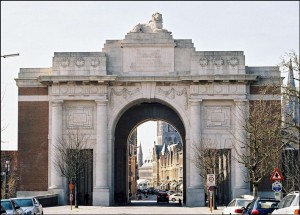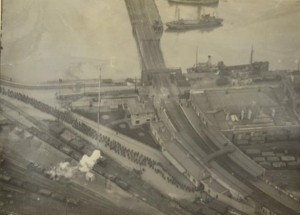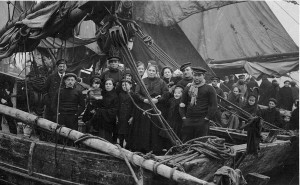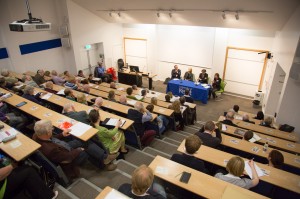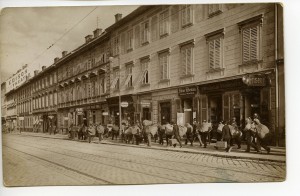Professor Mark Connelly, University of Kent
I first visited Ypres on a cold, wet day in the spring of 1987. I remember the Grote Markt and the Cloth Hall with its colonnade along its eastern face. My memory also brings back a sense of emptiness. In my mind’s eye the Grote Markt was completely empty. My recall is of no cars parked, no buses moving around it, just a massive space shiny wet in the drizzle. I returned in mid-July, and again my memory is of a quiet, sleepy little place. I remember walking up to the Menin Gate and on the corner of the road opposite its great east portico were very ordinary, non-descript little shops. I think one was a grocer or maybe a butcher’s. Of course, the timing of my visit was very interesting for it was in the immediate run-up to the seventieth anniversary of the opening of the Third Battle of Ypres. Yet, there was little sign that anything in particular was being planned. I can’t remember any notices giving details of special events or parades. All seemed immensely low-key. This is not to say that the people of Ypres were indifferent to the war and the impending anniversary, far from it. Anyone who has ever visited the city will know that at 8pm every evening buglers sound the Last Post under the great barrel vault of the Menin Gate, or the Hall of Memory as its designer, Sir Reginald Blomfield, so poignantly labelled it. It is a simple, but deeply moving act of respectful commemoration. No, the point I am making is that although the swelling tide of the Great War renaissance was well under way, it had not yet brought vast numbers of British people, especially school groups, on visits.
It was a few years before I visited Ypres again – probably five or six, in fact. On my return I was shocked. The Meninlaan was now a road of smart boutiques and shops. The Grote Markt was much busier and there was a car parking system in place. Going to the Last Post ceremony was no longer a case of turning up relatively late on and picking a good spot, but one that required arrival at least fifteen minutes before hand. Since then I have visited Ypres with increasing frequency, and so am part of the phenomenon in which British, and Commonwealth, particularly Australians, Canadians and New Zealanders, visitors have flooded into the city to see the gate, stand choked with emotion at the Last Post ceremony, visit the museum in the Cloth Hall… and buy chocolate tin helmets, drink the wonderful local beers and eat the equally great mussels and chips. The number of visitors now means even more careful timing for the Last Post ceremony. To stand any chance of getting a good view, arrival has to be at least 45 minutes before. Wreath-laying by a group, be it a school, British Legion party or regimental association, now occurs almost daily, and the summer months can be packed solid. As for visiting on Armistice Day, especially if it falls on the weekend, a visitor could well fail to get a view of the Menin Gate at all being forced to take up a place somewhere near the Grote Markt.
Yet, what are we all there for? What brought us to this charming, friendly West Flanders city? Trying to determine what motivates each and every visitor is, clearly, impossible. However, a few broad-brush suggestions can be made. One of the huge advantages and outcomes of digital communication is the availability of information and records. In turn, this has made genealogy much easier, and given the very bureaucratic procedures of the armed forces, we are all much more likely to find a family member who once performed some sort of military service. Then, given the ubiquity of Ypres in the British military experience of the Great War, it is hardly surprising that many people find out that their relative served, and possibly died, in the salient. Next comes the mystical appeal of the Great War itself. What has given it such a grip on our imaginations? Perhaps it is something to do with envy? In our world of cynicism, information coming at us from all angles bearing many different, often contradictory, messages at once, the men who went off to war in 1914 are bathed in a glorious light of certainty. No matter what became of them later, our hearts tell us that they signed up because they believed totally and utterly in the cause. Unconditional belief in a cause: how wonderful that seems. We also have the bitter-sweet sensations of power through knowledge of their fate which we often translate into a journey starting in innocence but often ending in brutal experience. We can pity them, and that gives power, but also makes us feel strangely powerless. If only we had a time machine, we could go back and warn them, tell them what we know and how they might avoid their fate. But we don’t, and so desperately feel the need to do something. We can go to where they served, suffered and perhaps died. We can stand there and conjure up some kind of communion with them. This is clearly an emotional journey with very little hard-headed, rational thinking about it, but emotions are powerful motivators and the visit to Ypres is often seen as the way of assuaging, or even exorcising, them.
Although I am professional historian in the wondrously privileged position of being paid to research and teach about the past, when I go to Ypres I definitely feel its emotional pull and it often crashes right through other bits of my thinking and feeling. By the same token, my obsession with the city itself, as opposed to the former battlefields beyond it, is not so much its wartime state as what happened to it from the end of the war and up to 1939. I am fascinated by how the local people returned to this shattered city and started rebuilding their houses, businesses, occupations and lives. I am fascinated by the fact that they lived in little wooden prefabricated bungalows. I am fascinated by the fact that almost instantly a tourist industry grew up and people started visiting the ruins and battlefields. When I go to Ypres I am desperate to find signs of them; to think about the kinds of places they would have visited, the people they would have met, the souvenirs they bought, the memories they brought home with them. I want to know more about the British people who decided to make Ypres their own home. By the mid-1920s there were enough of them to necessitate the building of a school, and for visitors to notice the existence of a permanent British community. It is for this reason that I am delighted to be writing a book that will explore these very ideas and questions. Ypres gets under the skin alright, but how much of that is because of what we impose on it by what is in our head and how much is because of real ghost inherent in the very fabric of the place, I really don’t know.
Read more about the Menin Gate and other war memorials at the Commonwealth War Graves Commission website: www.cwgc.org

